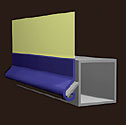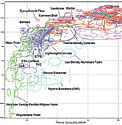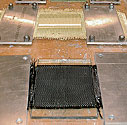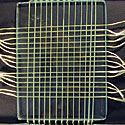New Technologies Create New Challenges
The design and construction of glass-and-metal building envelopes is well established and time-tested within the construction industry. Their performance is reliable and predictable. These building systems are generally made up of rigid, orthogonal, unitized components, the sizes of which are generally limited to what workers can move into position and then join together and attach to a structure. While this method of enclosing structures has been the standard for decades, Fernandez has been studying the rapid ascent, within the field of polymer science, of the development of high-performance textiles. His findings have been published in Material Architecture: Emergent Materials for Innovative Buildings and Ecological Construction (Architectural Press, an imprint of Elsevier, 2006).
Fernandez chose to explore his thesis, using materials already on the market. Finding a manufacturer to sponsor academic research takes time. After completing a white paper outlining the scope of his research, Fernandez spent a long 18 months making presentations to potential sponsors. In the end, he convinced Gore-Tex, a leader in composite textiles, to supply a dozen rolls of material for testing. Its technology is based on expanded polytetrafluoroethylene (PTFE)-better know as Dupont Teflon, and other fluoropolymer products. Whereas these products are now associated with waterproof, protective outerwear, Gore-Tex fluoropolymer products were originally meant to provide innovative solutions for next-generation cable assemblies for electronics, medical implants, and use with high-performance fabrics. Gore membranes have most of the characteristics required of building envelopes: moisture vapor permeability (breathability), but low water absorption; a high strength-to-weight ratio; low flammability; chemical inertness; and good weathering properties. In other words, the products were a perfect candidate for Fernandez's investigation.
|
|||||||||
Fernandez identified two obstacles in the way of a direct technology transfer. First, he had to consider the performance implications when a material is implemented in multiple layers; and secondly, how to detail the joints and restraints. With regard to the latter, Fernandez insists that there's a great deal of precedent in sailboat technology and existing tensile fabric structures to inform restraining techniques. Examples include Nicholas Grimshaw's ETFE pillows for the Eden Project and Richard Rogers's PTFE-coated Millennium Dome.
In an important development, experiments with those methods of curtain-wall assembly using textiles required in-depth reconsideration of the detail morphology, which typically defines rigid, orthogonal components. Textiles are strong in tension and ineffective in compression, so a very precise approach to connections is required. Also, nonstructural textiles, the kind of system Fernandez is most interested in, cannot completely prevent the movement of the exterior surface of the fabric caused by the gusting of wind, for instance.














